Our Equipment
DIGITAL X-RAYS
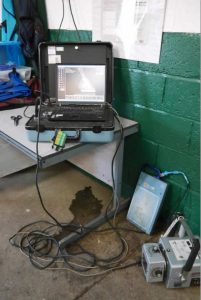 Radiographs, also known as x-rays, are particularly useful for imaging bones but can also give us some information about soft tissues.
Radiographs, also known as x-rays, are particularly useful for imaging bones but can also give us some information about soft tissues.
They are most useful for diagnosing fractures, bone infections and tumours, joint diseases such as arthritis and other conditions such as navicular disease and laminitis.
We are equipped with a BCF DR system which enables us to take a radiograph and have an image appear on the laptop within seconds. The software system modifies the image to give far more detail than was ever possible with conventional x-ray film.
This allows for accurate diagnosis and immediate formulation of treatment plans. It is also easy to burn these images onto a CD or memory stick for storage and we can either post or e-mail these images for your farrier or for second opinions from orthopaedic specialists.
It is a portable system which enables radiographs to be taken at a clients property. All that is required is mains electric and a flat clean surface with protection from the weather.
ULTRASOUND SCANNERS
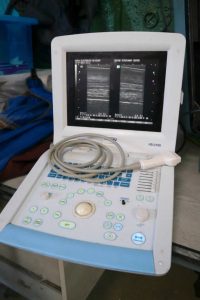 Ultrasound is one of the best ways to image soft tissues. In equine work there are two main uses for this machine. The first is in lameness diagnosis.
Ultrasound is one of the best ways to image soft tissues. In equine work there are two main uses for this machine. The first is in lameness diagnosis.
We can use the scanner to check for injuries in structures such as tendons. It allows us to assess how bad an injury is and give you a program of rest and exercise so that the injury has the best chance of healing.
The second main use is in reproductive work where the probe is inserted into the rectum and used to get a picture of the ovaries and uterus. This means we can identify any problems with these structures, such as ovarian cysts, or check whether the mare is pregnant.
If you want to put your mare in foal we can scan her each day around the time that she comes into season so we can tell when the mare is likely to ovulate.
This tells us when the mare should be taken to the stallion or artificially inseminated to give the best chance of success. We have two ultrasound scanners with which we can do reproductive and diagnostic tendon and soft tissue scans.
It is possible to either store the images on the scanner to enable monitoring of healing or to attach a printer and print the images off for storage or record.
ENDOSCOPY
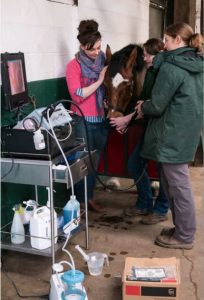 We have two endoscopes available to examine the respiratory tract, including the larynx, pharynx, guttural pouches and trachea.
We have two endoscopes available to examine the respiratory tract, including the larynx, pharynx, guttural pouches and trachea.
One is a shorter and narrower endoscope for use in smaller horses and ponies or to view the guttural pouches.
Tracheal wash samples to check for allergies and infections can be performed down either scope.
We also have a broncho alveolar lavage (BAL) tube to enable us to take samples from deeper down in the lungs.
The endoscopes can be used either at clients premises or at our clinic.
GASTROSCOPY
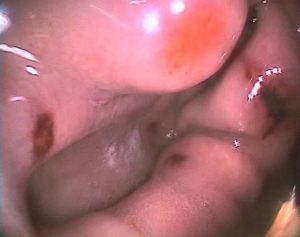 Gastric ulcers can cause a range of signs, from a grumpy temperament to weight loss and recurrent colic. The only reliable way to diagnose them is via gastroscopy – our 3m long video endoscope is passed into the stomach under standing sedation.
Gastric ulcers can cause a range of signs, from a grumpy temperament to weight loss and recurrent colic. The only reliable way to diagnose them is via gastroscopy – our 3m long video endoscope is passed into the stomach under standing sedation.
Your horse must be starved for 18 hours beforehand to allow the stomach to be empty enough so all of the stomach is visible with the camera – this means no straw bedding or turnout. We prefer to perform gastroscopy at the clinic, where they can also be starved overnight.
If you cannot come to the clinic, it can be taken to your yard if there are adequate facilities and power, but there is an extra charge for this.
For more information please see our Stomach Ulcer Information Sheet.
SHOCKWAVE TREATMENT
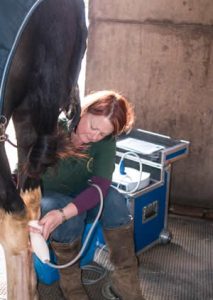
Shockwave Therapy is a non-invasive treatment that can speed the healing of many types of orthopedic and soft tissue injuries and conditions. A shockwave is a pressure wave.
The shockwaves used in equine medicine are generated in a fluid medium inside a transducer head and are then transmitted readily through skin, fat, and muscle. The high energy waves are focused within the transducer head so that the shockwave can be directed to the precise area of the injury.
Shockwave therapy has been successfully used to treat many soft tissue and bony problems, both acute and chronic.
These include, but are not limited to:
• Suspensory ligament tears and strains
• Tendon tears and strains
• Back pain
• Neck pain
Most conditions are treated a total of three times spaced at 2-3 week intervals. Occasionally, additional treatments will be required in more severe injuries. The treatments are easily performed at your yard, as long as there is mains electricity and protection from the weather, with the horse under mild sedation.
DENTISTRY
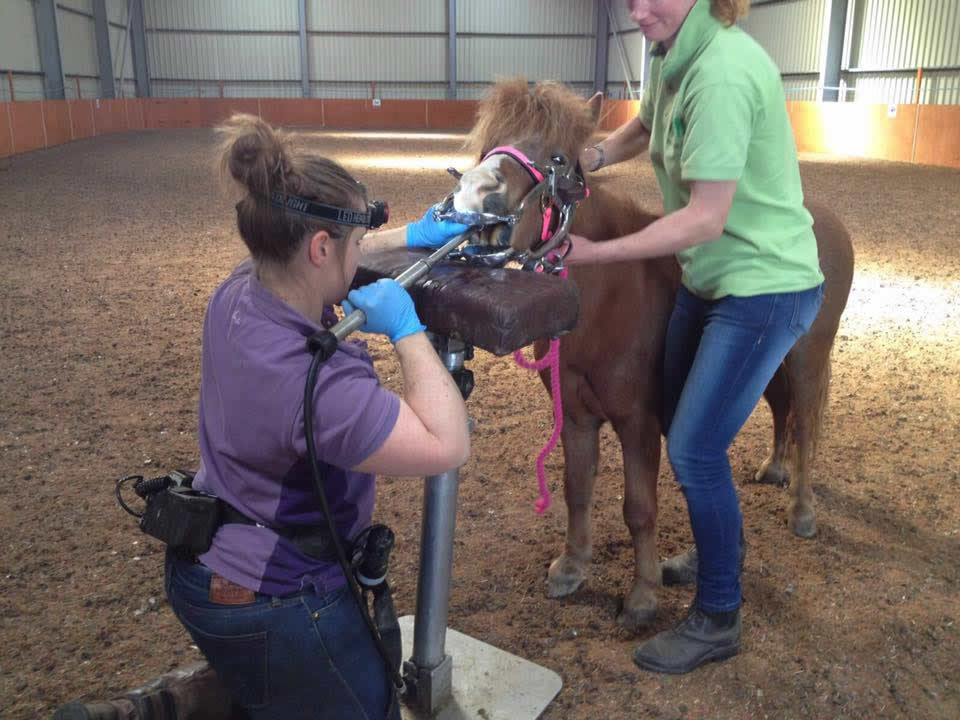 Modern equine dentistry is developing at a rapid rate. All horses should benefit from this.
Modern equine dentistry is developing at a rapid rate. All horses should benefit from this.
Horses teeth are different to human teeth, in that they continue to erupt throughout the life of the tooth.
As the horse chews its food, it grinds down the surface of the tooth resulting in development of sharp enamel points on the outside of the upper teeth & the inside of the lower.
These points can cause soft tissue ulceration. Routine rasping should be carried out at least once a year, and the time of your horse’s annual vaccination is an ideal time for us to do this.
Horses with problem mouths, or those which are competing in disciplines which require very sensitive aides, may need doing more regularly.
Correction of dental over growths can also be performed if required. We have motorised battery operated equipment to enable us to perform dentistry to a high standard at your premises, even if no electricity is available.
Some horses will require sedation for dentistry to be performed safely. This also allows us to perform a full detailed visual examination of a horse’s mouth using mirror & headlight, which can be dangerous in an unsedated horse.
Wolf tooth extraction can also be carried out at your stables, under standing sedation.
X-rays of teeth & roots can be carried out if required, either at your premises if mains electric is available, or at the centre.
We also have an oroscope, which provides digital images of the inside of a horse’s mouth, making detailed examination of a horse’s mouth much easier & visible to owners. This enables dental disease such as diastema (gaps), caries & gum disease to be spotted earlier, before clinical signs occur, enabling treatment to be carried out to prevent disease progression.
Advanced dental procedures, such as diastema work, extractions, cavity restorations, can be carried out at the centre, either by our own vets, or by visiting consultant Chris Pearce of the Equine Dental Clinic.
Find Us
Equine Veterinary Centre
Moorhouse Equestrian Centre
Gap Farm
Moorhouse Lane
Doncaster
South Yorkshire
DN6 7HA
Telephone 01977 652280
Emergencies
We are small enough to offer you a personal and professional approach but big enough to provide a high level of service and 24 hour emergency cover to our registered clients.
Opening Hours
Monday – Friday: 9:00 am – 5:30 pm
Saturday: 9:00 am – 12:00 pm
We are based in the countryside just off the Wakefield (A638) Road at Moorhouse Equestrian Centre and there is plenty of parking.
Would not have any other vets, all staff are friendly, caring and helpful, all vets are great at their job and also care about the horses.
Excellent service, highly recommended.
Fantastic veterinary practice – have looked after my medically challenged neddies for the last ten years, and have always gone above and beyond for all 3 of them.
Can’t thank the whole team enough – there’s always a friendly voice on the end of the phone when you’re panicking, and all of the vets are exceptional.
Would recommend to anyone who will listen!
Damien Cain is always very helpful, he provides a fabulous service to my ponies including telephone advice. Last week he worked alongside my dentist to help my old pony whom’s tooth had split, a further appointment to X-Ray him so we monitor the situation.
I have followed Damien around vet practices as I met him at his previous practice, when other vets wanted to box rest a pony for arthritis and with his help the pony became better with turnout.
When I require more medication the practice/office team are on the ball to get the medication out as soon as possible.
I once had lost faith with certain vets but trust was regained with Damien. Here is to hoping we only meet on vaccination visits.
Keep up the good work to all the Team